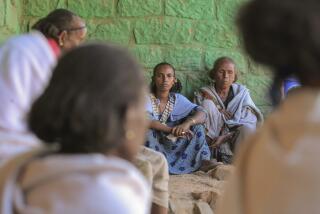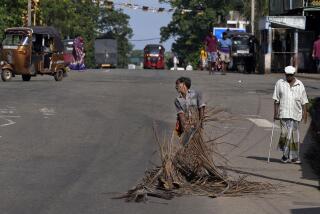Political Instability Worrisome : Zimbabwe Farms Prosper as Industrial Growth Lags
- Share via
HARARE, Zimbabwe — In the midst of drought and famine devastating much of Africa, Zimbabwe has managed to feed its 8.7 million people through three difficult years, and in this terrible drought year there is even food to export.
But industrial development has all but stalled in this southern African nation--under the impact both of the natural disaster and as a result of Zimbabwe’s own economic mistakes. Long-term growth could be further jeopardized by political instability.
And there are other aggravations that inhibit the nation’s growth: unwillingness by the increasingly one-party government of Prime Minister Robert Mugabe, a socialist, to offer foreign investors the same inducements that other developing countries do; political and ethnic conflict with the minority Ndebele tribe, led by Joshua Nkomo’s Zimbabwe African People’s Union, and an annual population increase of more than 3.5%.
But full bellies count for a lot in Africa today, and Zimbabwe will harvest near-record amounts of corn, the country’s staple, and of tobacco and cotton, both major export crops.
“We are making an amazing recovery,” said John Laurie, president of the Commercial Farmers Union. “The value of our output will rise more than 50% this year. That should be a tremendous boost to the whole economy.”
Sen. Denis Norman, a successful corn and tobacco farmer who is also Zimbabwe’s minister of agriculture, similarly sees in this year’s harvest not just an end to the drought, the worst on record here, but the start of a process of economic growth that could transform the country’s impoverished rural areas, home to three-quarters of the 8.7-million population.
The “near miraculous” part of Zimbabwe’s agricultural recovery, Norman says, is not the bumper harvest expected by the country’s 4,400 highly productive large farmers, generally whites who have remained under black rule, but the unexpected and increasing success of small-scale farmers who a few years ago grew only enough to feed their families.
Half of this year’s corn and cotton deliveries to state marketing boards will come from peasant farmers, Norman said. Put another way, in 1981, their best year until then, peasants sold only 80,000 tons of corn; this year, they will deliver more than 900,000 tons to the grain marketing boards after feeding their own communities.
‘Peasant Is Catching Up’
“No country can afford to have 47% of its land farmed on a subsistence basis,” Norman said, recounting the government’s efforts over the last five years to raise the productivity of the small-scale farmer with better seeds, fertilizers and pesticides, technical advice, government credits and marketing assistance. “The peasant is now catching up in yield to the commercial farmer.”
The significance in areas that have suffered from malnutrition is not just full bellies but full pockets as well, which should in turn generate new demands for industrial products, ranging from agricultural chemicals and machinery to clothing and other consumer goods. Rural prosperity, economic planners here hope, should turn the 800,000 peasant farmers and their families into a large new market for Zimbabwe’s industry.
“The farmers, big and small, could pull us out of the industrial downturn this year,” a bank economist said. “Demand is already picking up, and factories are gearing to operate at near-normal levels.”
3% Real Growth
Zimbabwe’s gross national product, the total of the country’s goods and services, should grow to about $5.2 billion this year at current exchange rates. This represents an increase of about 3% in real terms, after three years of reductions in the GNP, totaling about 13%.
But Zimbabwe, like much of the rest of Africa, has a population problem, growing by more than 3.5% a year. This means that real production per capita has declined 15% between 1982 and 1984 and is now at the lowest point since 1968, according to estimates by the Standard Chartered Bank Group’s economists here. Real personal income has fallen about 17.5% in the last three years; about 50,000 jobs have been lost since 1982, and unemployment is estimated at 12%.
“The economy has been bungled, badly bungled, for the past five years, in the government’s mad pursuit of socialism,” said John Nkomo, administrative secretary of the Zimbabwe African People’s Union and a government minister until his ouster last November. Nkomo, who is not closely related to Joshua Nkomo, the party leader, explained:
“The drought had an undeniable impact over the last three years, but our problems are not really in agriculture. Factories have closed by the dozens, industrial production has been scaled back, thousands of workers have been retrenched, new investment is simply zero.
“This contraction of the economy is as much due to the government’s policies in spending money we did not have; in letting inflation rise to 15%, 20% and even 25% in some years, and in scaring investors with talk of nationalization and all sorts of regulations that mean they cannot get a fair profit. This government has pushed too hard for socialism without thinking its policies through.”
Businessmen and bankers make similar points, though in less hostile political terms, and government officials acknowledge that there is some truth in them.
Investors Wary
After a decade of underinvestment, going back to the last years of the Rhodesian civil war of the 1970s, during which industrialists did little to modernize or expand, Zimbabwe needs new investment. But it is getting little such money outside the farm sector.
One reason is the widespread lack of investor confidence, which has been diminished not only by Mugabe’s commitment to the country’s “socialist transformation” and talk of nationalizing certain industries, but by price controls, increased minimum wages and a slow and inexperienced government bureaucracy.
Zimbabwe has offered potential foreign investors, whom it briefly wooed after independence five years ago, few incentives compared to those in other developing countries. For example, it has declined so far to sign an agreement with the U.S. Overseas Private Investment Corporation, a step that would let American firms insure their property here against government seizure.
A second factor cited by businessmen and bank economists for the low level of new investment has been the increasingly acute shortage of foreign exchange needed to import machinery and other new equipment.
Since 1980, the government’s allocations of foreign exchange to industry and commerce have declined by more than 60% in real terms. And since strict controls were introduced a year ago to conserve the country’s dwindling reserves by limiting imports and restricting the remittance of foreign firms’ profits, there has been little money even to purchase raw materials and spare parts abroad.
Reduced export earnings, particularly from agriculture, the need to import emergency food stocks during the drought, and the government’s own high spending levels are blamed for the balance of payments deficit.
Staggering Debt Service
But Zimbabwe is likely to have a surplus this year, according to present estimates, and businessmen are now praising the government’s determination to end the deficit. The country must nevertheless spend about 30% of its foreign earnings each year for payments on its accumulated $2 billion in foreign debts.
Help might come later this year from the International Monetary Fund, according to bankers here, but the fund would probably require reduction of the government’s huge budget. The budget totals about $2.8 billion, including a $642-million deficit, and accounts for about half Zimbabwe’s gross national product.
Mugabe is determined, however, to keep the promises that his governing Zimbabwe African National Union made when it came to power in 1980--pledging to provide the social services, educational opportunities and rural development that were denied the country’s black majority for so long under white rule.
Trimming the budget will be difficult, particularly in an election year, for there are 50% more workers on the government payroll now than there were five years ago, and there are food subsidies and scores of schools, clinics and other facilities still to be built.
Economic development is further clouded by the hostility between Mugabe’s dominant party, whose members are largely from the majority Shona people, and the rival Zimbabwe African People’s Union, almost all minority Ndebele. Violence between them rages over about a quarter of the country.
“We are in a terrible dilemma at the moment,” a staff economist for one of Zimbabwe’s largest corporations said. “We need to invest very substantially in new industrial capacity and plant modernization. We need to create 100,000 to 150,000 new jobs a year, and that requires $1 billion to $1.5 billion. We hope we can take advantage of the opportunities that this year’s harvest will give us.”
A Resilient Economy
Even those most critical of the government’s policies believe in the basic resilience of Zimbabwe’s highly diversified economy, whose strength was demonstrated in the ability to handle both a drought and recession over the last three years.
A new, more realistic development plan is now being worked out, government officials say, and socialism will be treated as a goal for the distant future, with the state buying its way into industry rather than nationalizing private companies.
“The private sector should be left alone to continue to compete with the public sector,” one of the government’s top ministers, Maurice Nyagumbo, a member of the Zimbabwe African National Union’s policy-making Politburo, said in an interview. “The private sector should be left intact so the state gains technology and management experience from it. Our socialist transformation will be extended, and it will not be given a timetable. . . . Our policies will justify the people’s confidence.”
That optimism may be strongest among the country’s commercial farmers, whites who chose to stay on after black rule came in 1980.
“We are feeling positive, very positive, about the future,” Laurie, the president of the Commercial Farmers Union, said. “We have very big investments, and we are investing even more money. We have a large number of young farmers again--the average age has dropped from 54 to 37--and that means that the sons of farmers have decided to stay and make agriculture in Zimbabwe their careers. This is genuine confidence in the country’s political and economic future.”
More to Read
Sign up for Essential California
The most important California stories and recommendations in your inbox every morning.
You may occasionally receive promotional content from the Los Angeles Times.










